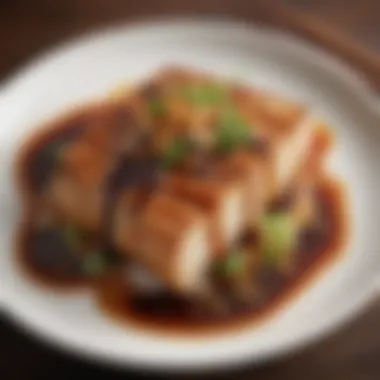Ultimate Guide to Gluten-Free, Soy-Free Teriyaki Sauce


Intro
Exploring the realms of gluten-free and soy-free cooking opens up a vast diversity of flavors and techniques. In the case of teriyaki sauce, a beloved condiment often utilized in Asian cuisine, special attention to alternative ingredients is crucial. Teriyaki typically relies on soy sauce and sugar, leading to concerns for those with dietary restrictions related to gluten or soy.
This discussion not only highlights the significance of alternative ingredients but also sheds light on their nutritional implications. As dietary preferences evolve, so does the need to adapt traditional recipes to cater to a broader audience.
In this guide, readers will gain insights into various aspects of gluten-free, soy-free teriyaki sauce, from ingredient selection to preparation methods. The article aims to empower food enthusiasts to diversify their culinary repertoire without compromising on taste or health considerations. Whether you are looking to enhance an Asian-inspired dish or wanting to experiment with new flavors, this guide provides a comprehensive look into making teriyaki sauce that meets diverse dietary needs.
Prelims to Teriyaki Sauce
Teriyaki sauce, known for its sweet and savory flavor, has garnered global popularity. This section emphasizes the significance of understanding teriyaki sauce, especially when exploring gluten-free and soy-free alternatives. As people become more conscious about diet and health, particularly regarding food allergies and intolerances, acknowledging the original elements of teriyaki sauce is critical. It allows culinary enthusiasts to create a version that maintains the essence of traditional teriyaki while accommodating dietary needs.
Historical Perspective
The origins of teriyaki sauce can be traced back to Japan, where the word "teriyaki" translates to a cooking method that involves grilling or broiling, typically glazed with a soy sauce mixture. The method has evolved over centuries, integrating local ingredients and practices. Understanding the history helps appreciate how teriyaki sauce has transcended borders, leading to its inclusion in various cuisines around the world. Historically, the sauce was a way to enhance the flavors of grilled meats while also providing a shiny glaze and distinct aroma. As cooking methods and tastes have changed, so too have the recipes.
Traditional Ingredients
Traditional teriyaki sauce consists mainly of soy sauce, sake, mirin, and sugar. Each ingredient plays a significant role in creating the desired taste profile. However, for those avoiding gluten and soy, these ingredients pose challenges. In understanding what makes the traditional version appealing, we also explore alternative ingredients that can replicate the taste without compromising dietary restrictions. For example, coconut aminos serve as a popular substitute for soy sauce, providing a similar umami flavor along with a lower sodium content.
Modern Adaptations
The rise in dietary restrictions has led to innovative adaptations of teriyaki sauce. Many culinary enthusiasts and food producers have experimented with various sauces that align with gluten-free and soy-free requirements. These modern variations often incorporate unique sweeteners, like maple syrup or agave nectar, alongside alternative thickening agents such as arrowroot powder or cornstarch. The exploration of these adaptations opens up a broader spectrum of flavors, making teriyaki a versatile sauce suitable for numerous dishes. Understanding these adaptations is essential for anyone looking to recreate teriyaki sauce while keeping dietary needs in mind.
The Necessity of Gluten-Free and Soy-Free Options
In recent years, there has been a significant shift in how people approach their diets. This shift is largely driven by increased awareness surrounding food sensitivities and allergies. The necessity for gluten-free and soy-free options, particularly in sauces like teriyaki, is more relevant than ever. Many individuals are now seeking alternatives due to various health concerns and lifestyle choices. Understanding this necessity can enhance culinary experiences and broaden food accessibility.
Understanding Dietary Restrictions
Dietary restrictions can stem from several factors including allergies, intolerances, or personal dietary choices. Gluten, a protein found in wheat, barley, and rye, affects a considerable number of people, especially those with celiac disease. Soy, on the other hand, frequently appears in Asian cuisine, serving as a major ingredient in many sauces. However, for individuals with soy allergies or sensitivities, this can limit their food options significantly. By offering gluten-free and soy-free teriyaki sauce alternatives, we can cater to a more diverse audience. This not only demonstrates inclusivity but also ensures everyone has access to flavorful options.
Health Implications of Gluten and Soy
The health implications surrounding gluten and soy are well documented. Consumption of gluten can lead to severe health reactions in individuals with celiac disease or gluten sensitivity, including gastrointestinal distress and inflammatory responses. Soy can cause allergic reactions as well, ranging from skin irritations to digestive problems. Thus, creating a teriyaki sauce without these ingredients can be an important step in fostering a safe dining environment. Moreover, people looking to avoid these ingredients often report feeling better overall. Their awareness of ingredient content and health implications shows a shift toward more mindful eating.
Culinary Trends in Food Substitutes
The contemporary culinary landscape is marked by innovation, particularly in the realm of food substitutes. People are increasingly interested in alternatives that satisfy both texture and flavor. The rise of plant-based diets and the movement toward clean eating are transforming how sauces are formulated. Ingredients such as coconut aminos or other natural sweeteners are gaining popularity as substitutes for soy sauce in teriyaki mixes. Consumers are more engaged than ever, looking for options that fit their values regarding health and sustainability. This trend has implications not just for individuals, but also for food producers who must adapt their offerings to meet these changing consumer demands.
"More and more individuals are making conscious choices about their meals, leading to a growing need for gluten-free and soy-free products. This goes beyond just preferences—it's about safety and health."
Overall, understanding the necessity of gluten-free and soy-free options is crucial in today's food culture. An awareness of dietary restrictions, health implications, and culinary trends allows for the development of innovative products that cater to an expansive range of consumers. This sets the stage for creative formulations in sauces, enhancing culinary experiences for many.
Crafting Gluten-Free, Soy-Free Teriyaki Sauce
Crafting gluten-free and soy-free teriyaki sauce is essential in today's diverse culinary landscape. Many people have dietary restrictins that require alternatives to traditional sauces. This section will outline the vital components for creating this sauce, focusing on essential ingredients, preparation methods, and serving suggestions. A thoughtful approach to crafting this teriyaki sauce can enhance both flavor and nutritional value, making it a fitting choice for various diets.
Essential Ingredients
Alternative Sweeteners
Alternative sweeteners are fundamental in gluten-free, soy-free teriyaki sauce. These sweeteners can take the place of sugar and typical soy sauces that contain gluten. Popular options include honey, agave nectar, and coconut sugar. These sweeteners provide varying flavor profiles.
- Key Characteristic: They are naturally derived, making them a healthier choice.
- Benefits: They add sweetness without refined sugars, and some options offer lower glycemic indexes.
- Disadvantages: Not all alternatives may work well with every recipe. For example, honey can alter the consistency of the sauce, making it thicker.
Thickening Agents


Thickening agents play a crucial role in achieving the ideal consistency for teriyaki sauce. Gluten-free options include cornstarch and arrowroot powder. These agents help to create a smooth and appealing sauce.
- Key Characteristic: They effectively thicken liquids without using gluten-containing flour.
- Benefits: They result in sauces that cling well to food, enhancing texture.
- Disadvantages: They may require additional adjustments to quantities, as too much can make a sauce overly thick or gummy.
Flavor Enhancers
Flavor enhancers add depth and complexity to gluten-free, soy-free teriyaki sauce. Ingredients such as garlic powder, ginger, and chili flakes can introduce a necessary layering to the dish. These enhancers are vital for creating a teriyaki sauce that does not feel lacking despite the absence of traditional soy sauce.
- Key Characteristic: They boost overall flavor without introducing gluten or soy.
- Benefits: They allow for custom flavors, catering to personal taste preferences.
- Disadvantages: Overuse of strong flavors can easily overwhelm other components, requiring careful balance.
Preparation Process
Mixing Techniques
Mixing techniques are crucial for achieving a well-blended teriyaki sauce. Properly combining ingredients ensures even distribution of flavors and a consistent final product. A whisk or a blender can be used depending on the texture desired.
- Key Characteristic: Good mixing leads to emulsification, particularly when using thickening agents.
- Benefits: Well-mixed sauces enhance uniform flavor.
- Disadvantages: Some methods may require more time and effort, especially when manually mixing.
Cooking Methods
Cooking methods also affect the outcome of the teriyaki sauce. Common techniques include simmering and reducing the sauce to enhance flavors.
- Key Characteristic: Simmering allows flavors to mature and integrate well.
- Benefits: This method creates a concentrated flavor, improving taste significantly.
- Disadvantages: Overcooking can lead to burnt flavors or unintended texture changes.
Adjusting Flavor Profiles
Adjusting flavor profiles is essential when crafting teriyaki sauce. Tasting during preparation allows for modifications in sweetness, saltiness, and spices.
- Key Characteristic: Flexibility is key in creating a balanced sauce.
- Benefits: This ensures the sauce meets personal preferences.
- Disadvantages: It requires experience to know when to adjust, particularly for those new to cooking.
Serving Suggestions
Pairing with Proteins
Pairing teriyaki sauce with proteins like chicken, beef, or tofu can enhance the dish's appeal. Each protein absorbs flavors differently, making the sauce versatile.
- Key Characteristic: Teriyaki sauce complements various proteins.
- Benefits: This versatility can lead to creative meal options.
- Disadvantages: Not all proteins may pair well; some may require additional seasoning.
Saucing Vegetables
Using teriyaki sauce on vegetables can provide additional flavor and encourage the consumption of veggies. Stir-frying or glazing vegetables with the sauce brings a vibrant element to any dish.
- Key Characteristic: Vegetables take on the sauce's sweet and savory notes well.
- Benefits: This method enhances nutritional value while offering delightful flavors.
- Disadvantages: Over-saucing can lead to soggy textures.
Use in Marinades
Finally, using teriyaki sauce as a marinade can add depth to meats and vegetables before cooking. This method allows flavors to penetrate and improve overall taste.
- Key Characteristic: Marinades help ingredients absorb flavors ahead of cooking.
- Benefits: This technique amplifies the dish's overall flavor familiarity.
- Disadvantages: Prolonged marination may overpower more delicate ingredients.
Nutritional Considerations
Understanding the nutritional considerations of gluten-free and soy-free teriyaki sauce is essential for those who prioritize their dietary choices. The sauce's impacts go beyond mere flavor; they influence overall health, energy levels, and nutritional balance. This section provides a detailed analysis of caloric content, essential vitamins and minerals, and how teriyaki sauce fits into a balanced diet.
Caloric Content Analysis
When assessing the caloric content of gluten-free, soy-free teriyaki sauce, various factors come into play. Depending on the ingredients used, the calorie count can vary significantly. Typical ingredients like coconut aminos and alternative sweeteners can lead to a lower caloric count compared with traditional soy sauce. On average, a tablespoon of homemade gluten-free teriyaki sauce can range from 10 to 25 calories. This lower calorie content makes it a suitable choice for those watching their weight while still craving savory flavors.


Vitamin and Mineral Inclusion
Vitamins and minerals enhance the health benefits of teriyaki sauce. Depending on the specific ingredients, these sauces can be enriched with essential nutrients. For example, using brown sugar or coconut sugar as sweeteners can add small amounts of minerals such as potassium and magnesium. Additionally, incorporating garlic or ginger provides health benefits along with flavor, as both are known for their anti-inflammatory properties. Therefore, choosing ingredients wisely allows you to elevate the nutritional profile of the sauce itself.
Impacts on Dietary Balances
Creating a gluten-free and soy-free teriyaki sauce can greatly affect dietary balances. By eliminating gluten and soy, individuals may experience better digestion and could notice improvements in overall well-being. However, it is important to ensure the sauce still contributes to a well-rounded diet. Incorporate it alongside whole foods, fresh vegetables, and healthy proteins to ensure a balanced meal. Utilizing teriyaki sauce as a marinade or dressing can add flavor without compromising health, but one must consider the increased sugar content in some variations. Thus, moderation and awareness are crucial in maintaining an overall healthy diet.
"The way we craft our sauces can greatly influence our nutritional choices and overall health."
In summary, understanding the nutritional considerations behind gluten-free and soy-free teriyaki sauce is vital in today's health-conscious environment. Caloric content, vitamin and mineral inclusion, and impacts on dietary balances are key aspects that should not be overlooked as you create flavorful meals. Emphasis on nutritious ingredients can lead to both satisfying and healthful culinary experiences.
Storage and Shelf Life
When it comes to homemade gluten-free and soy-free teriyaki sauce, storage and shelf life are essential elements to consider. Proper storage ensures that the sauce maintains its quality and nutritional value over time. As with any culinary product, the way you store teriyaki sauce impacts its flavor, texture, and safety.
A well-stored sauce can keep its taste and prevent spoilage, ultimately leading to a better culinary experience. Conversely, improper storage may lead to waste and the risk of consuming spoiled ingredients, which can pose health risks. This section will outline best practices for storage and guide you on how to identify signs of spoilage in your teriyaki sauce.
Best Practices for Storage
To optimize the shelf life of your gluten-free, soy-free teriyaki sauce, consider these best practices:
- Glass Jar or Container: Store the sauce in a clean glass jar or container with a tight-sealing lid. Glass is preferable as it does not interact with the liquid as some plastics might.
- Cool, Dark Place: Keep the sauce in a cool, dark area, such as a pantry or cupboard. Avoid direct sunlight, which can degrade the flavor over time.
- Refrigeration: If you've made a larger batch, consider refrigerating it. Cold storage can extend the shelf life significantly.
- Expiration Labeling: Label your container with the date of preparation. This simple step helps you to track how long the sauce has been stored.
Identifying Spoilage Signs
Even with proper storage, it is crucial to know how to recognize any signs of spoilage. This helps in ensuring safety and quality. Look for these indicators:
- Off Smell: If the teriyaki sauce emits an unusual or unpleasant odor, it's best to discard it.
- Change in Color: Any significant change in color may suggest chemical changes. For example, a darker or more opaque appearance can be a sign of spoilage.
- Separation or Settling: While some separation can happen naturally, excessive layers or sediment may indicate spoilage.
- Mold Growth: Any visible mold on the surface or within the sauce is a clear indication of spoilage. When you notice this, throw the sauce out immediately.
Utilizing the above practices and knowing spoilage signs can significantly enhance your culinary experience by ensuring a longer shelf life for your homemade teriyaki sauce. This a crucial aspect that every home chef should be aware of.
Creative Uses of Teriyaki Sauce
Teriyaki sauce, especially in its gluten-free and soy-free form, is a versatile ingredient that can uplift a wide variety of dishes. Understanding its creative uses not only broadens culinary horizons but also allows for experimentation with flavors. This sauce is not just for one type of cuisine; it can complement many eating styles. Whether it is sweet, savory, or a blend of both, teriyaki sauce brings layers of taste without overwhelming the dish.
In Marinades and Dressings
One of the primary functions of teriyaki sauce is as a marinade. Its combination of sweetness and umami flavors makes it particularly effective for tenderizing meats. When combined with protein, the sauce infuses the meat with its rich taste, resulting in a more flavorful dish.
For a simple marinade, consider mixing teriyaki sauce with garlic and ginger. This adds depth to the flavor profile. Fish, chicken, or pork can benefit significantly from such preparation. Letting proteins sit in the marinade for at least 30 minutes, or even overnight, enhances the overall taste, making it far superior to unseasoned alternatives.
Also, teriyaki sauce can be incorporated into salads as a dressing. By blending it with vinegar or oil, a delightful dressing is formed. This enhances salads, adding both flavor and a touch of richness with minimal effort.
In Stir-Fries and Grilled Dishes
Stir-fries are another excellent way to utilize teriyaki sauce. The quick cooking method allows vegetables and proteins to retain their textures while absorbing the sauce’s flavors. Broccoli, bell peppers, and carrots combined with chicken or tofu create a dish that is both nutritious and satisfying. Simply sauté the desired ingredients and add teriyaki sauce towards the end to achieve an optimal glaze.
Grilling is yet another avenue for teriyaki sauce. When brushed on meats or vegetables, it caramelizes beautifully, producing a smoky flavor that is irresistible. The sauce can be used as a finishing glaze that not only enhances the food visually but also adds a complex flavor profile. Consider skewers with bell peppers, onion, and shrimp coated lightly with teriyaki sauce for an easy yet delightful meal.
In Soups and Stews
Incorporating teriyaki sauce into soups and stews might not be the first thing one thinks of, but it can elevate these dishes significantly. Adding a few tablespoons can deepen the broth's flavor and add a touch of sweetness that balances the other savory ingredients.
When making a chicken or vegetable soup, teriyaki sauce can serve as a flavorful enhancement. Instead of using only salt for seasoning, adding a little teriyaki sauce can introduce both taste and complexity. It works especially well with Asian-inspired soups.
Moreover, in stews, teriyaki sauce can harmonize beautifully with ingredients like mushrooms and carrots, creating a hearty meal perfect for any time of the year.


Using gluten-free and soy-free teriyaki sauce opens up numerous possibilities. The key is to experiment, as the sauce works well with varied cuisines and cooking methods.
In summary, teriyaki sauce stands out as a multifunctional ingredient that enriches many dishes. Its application as a marinade, dressing, or flavor enhancer in stir-fries and soups demonstrates its flexibility in the kitchen. Cooking can become an exciting journey through flavors, especially when one does not shy away from trying new combinations.
Exploring Alternative Recipes
Exploring alternative recipes for teriyaki sauce is essential for those navigating dietary restrictions or seeking to broaden their culinary horizons. This section delves into the variations and regional influences that can enrich your cooking experience. By incorporating alternative recipes, you not only find satisfying substitutes but also discover new flavor profiles and textures that enhance the enjoyment of your dishes. It allows for more creativity in the kitchen, caters to diverse tastes, and promotes inclusivity in shared meals.
Variations on Teriyaki Sauce
Variations on teriyaki sauce are as diverse as the ingredients that one can use. Customizing a sauce can lead to unique flavor combinations tailored to personal preferences. Here are some alternatives that can act as key components:
- Coconut Aminos: This soy sauce substitute is a popular choice. It is made from the sap of coconut blossoms and can add a mild sweetness to your sauce, making it a great alternative for those allergic to soy.
- Apple Cider Vinegar: Incorporating apple cider vinegar can provide a tangy flavor that balances the sweetness. This option works well when you need a hint of acidity.
- Maple Syrup or Agave Nectar: As a sweetener, these options can replace traditional sugar to provide a unique sweetness and depth to the sauce.
- Sesame Oil: Adding toasted sesame oil not only enriches the flavor but also contributes to a distinct nuttiness that enhances the overall taste of the sauce.
Some individuals may also explore fruit-based variations. Ingredients like pineapple, mango, and even peach can provide a vibrant twist, bringing a fresh and fruity dimension to teriyaki sauce. When creating variations, it is also important to consider the balance of flavors. A successful sauce will have a harmonious blend of sweet, salty, and acidic notes.
Incorporating Regional Flavors
Incorporating regional flavors into teriyaki sauce opens up a world of culinary innovation. Different cultures offer unique ingredients and techniques that can create an intriguing fusion. Here are several perspectives:
- Korean Influences: Adding gochujang, a fermented chili paste, introduces a spicy and umami-rich flavor to the teriyaki sauce. This not only brings heat but also complexity to the sauce, reflecting Korean culinary principles.
- Thai Inspirations: Infusing flavors with lemongrass or kaffir lime leaves can elevate teriyaki sauce, bringing in a fresh and aromatic quality. These elements contribute individualistic tastes, encouraging adventurous palates.
- Japanese Tradition: Traditionally, teriyaki sauce enhances grilled meats and vegetables in Japanese cuisine. Exploring variations that include miso or yuzu can add authenticity and depth, aligning with the original flavor profiles.
By experimenting with these regional influences, cooks can create sauces that are not only gluten-free and soy-free but also rich in cultural narratives and delectable experiences. The ability to personalize recipes based on regional tastes reflects a deeper connection to food and dining experiences.
Consumer Awareness and Labeling
Consumer awareness regarding gluten-free and soy-free teriyaki sauce plays a crucial role in today's culinary landscape. With the rise of dietary restrictions, informed choices can significantly impact health and satisfaction in food consumption. The careful selection of ingredients not only determines the quality of the sauce but also influences overall well-being. Understanding labeling practices allows consumers to avoid unwanted allergens and additives, leading to safer culinary experiences.
Reading Ingredient Labels
Ingredient labels provide vital information for anyone suffering from gluten or soy allergies. It's imperative for consumers to know how to read these labels effectively. Terms like "gluten-free" and "soy-free" can be misleading, and manufacturers sometimes use different nomenclature.
When examining a label, it is important to look for:
- Clear allergen declarations: The best products should clearly state if they are gluten and soy-free.
- Ingredient lists: Consumers need to familiarize themselves with less common ingredients that might contain gluten or soy derivatives. Ingredients like malt or certain starches can often hint at hidden gluten sources.
- Certifications: Products with third-party certifications might provide additional assurance about their gluten and soy-free status. Labels from organizations such as the Gluten-Free Certification Organization can be very helpful.
"Understanding what is in your food is the first step to a healthier lifestyle."
Keeping a mental checklist of potential allergens can simplify grocery shopping significantly. If a product claims to be gluten-free or soy-free, keep in mind that verification through labels is necessary.
Understanding Cross Contamination Risks
Even if a product does not contain gluten or soy in its listed ingredients, cross contamination poses a considerable risk. This occurs when traces of gluten or soy mix with otherwise safe products, often during packaging or processing. Educating oneself about this risk is essential for those who have severe allergies.
To minimize risks related to cross contamination:
- Choose certified gluten-free brands: These brands typically adhere to strict standards to prevent cross contact.
- Read labels carefully: Always look for disclaimers such as "may contain traces of" or "produced in a facility that processes soy/gluten."
- Be aware of bulk items: Buying loose products can introduce contamination risk if not handled properly.
Closure
The conclusion serves as a vital component of this article, consolidating knowledge that readers have gathered regarding gluten-free and soy-free teriyaki sauce. It is not simply about reiterating information but emphasizes the significance of understanding alternative sauces in contemporary culinary practices. More and more individuals are recognizing dietary restrictions and preferences, making it crucial to provide inclusive options.
Recap of Key Points
- The history of teriyaki sauce reveals its rich cultural roots, evolving over time into a versatile condiment.
- Nutritional considerations highlight the benefits of gluten-free and soy-free diets, addressing health implications for the consumer.
- The recipes presented showcase how to create flavorful teriyaki sauce using alternative ingredients, focusing on essential components and the preparation process.
- Awareness of food labeling and cross-contamination risks is critical for individuals with dietary restrictions, ensuring safe consumption.
- Creative applications of teriyaki promote culinary innovation, demonstrating how it can be used beyond traditional dishes.
Future of Gluten-Free and Soy-Free Cooking
The future of gluten-free and soy-free cooking is promising. As the demand for inclusivity grows, culinary practitioners and food enthusiasts will likely continue to explore and develop recipes that cater to various dietary needs. There will be an increased focus on sourcing unique flavor enhancers and alternative ingredients to ensure the culinary experience remains diverse and rich.
Additionally, advancements in food technology and awareness in nutrition will contribute to exciting developments in this area. More brands may emerge that specialize in gluten-free and soy-free products, addressing consumer demand directly. This evolution will likely inspire home cooks as well.
Overall, the exploration of gluten-free, soy-free teriyaki sauce is a testament to the diverse and dynamic world of food. As individuals continue to make informed choices for their health and palate, a well-informed approach from food enthusiasts becomes invaluable.















